|
Farley Mount's chilling
formation
I would first like to thank those whose efforts have
ensured that first class photographs of this intriguing structure are
available at The Crop Circle Connector - in this case, The Hampshire
Flyer and Nick Bull. We are all indebted to you.
Preliminary Note
If hyper intelligent beings really are responsible for at least some of
the artistry we've been seeing in our fields, for many years [and I have
powerful evidence that they are]*, then their creations should be
readable by the earthlings they were intended for. Any failure to
achieve that basic objective would make the whole exercise absurd. All
that is needed for interpreting the many communications correctly, I
believe, is a methodology that's based on universally recognised logic
and not hyperbole, and I've been endeavouring to stick to that approach
for many years. The foundation for each of my analyses is also
simplicity.
In this case, then, my first task was to engage in the elementary act of
counting the areas of standing crop that can be seen within the large,
outer circle. This revealed that a single ring, at the edifice's centre,
is encompassed by 80 other zones and these are set out in four groups of
15 quadrilateral-like shapes [in '5-4-3-2-1' configurations] together
with four lines of five lens-like figures, as shown in the graphic below
[which is based on an image by Nick Bull]:
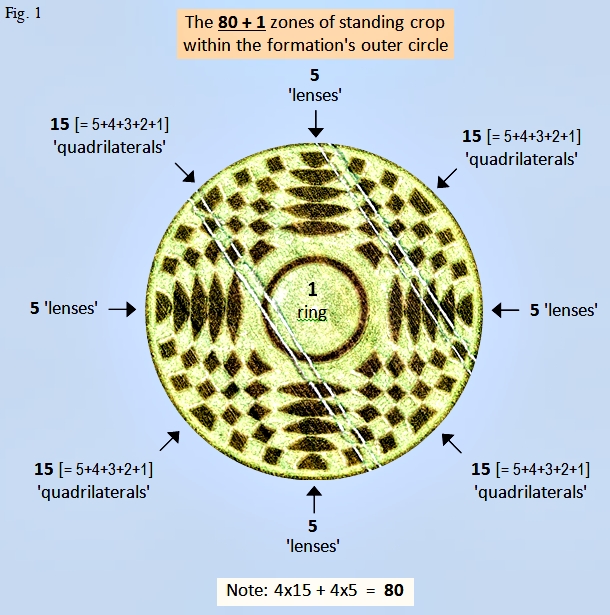
This
arrangement intrigued me because I knew that all intelligent species
with an advanced knowledge of science - both within our planetary home
and outside it - would know that '80' represents the quota of stable
chemical elements that exist. In other words, this number is of key
importance in Chemistry and, as such, could be employed in a scholarly
communication. Furthermore, the presence of the one, conspicuous circle
at the centre of the array of 80 other structures appeared to reinforce
this idea.
I knew that another element, bismuth, possesses an isotope [bismuth-209]
that's so long-lived its half-life has been estimated to be more than a
billion times the universe's age. It's the case, then, that bismuth
fails to possess a stable nuclide by a margin that is infinitesimally
small - even by the exacting standards of modern science. The
possibility therefore occurred to me that this unique element is being
denoted by the cited circle at the formation's centre - so it is being
included alongside what I suspect are representations of the 80 known,
stable elements. And when I considered this hypothesis further, I
quickly uncovered support for it.
Firstly, knowing that intense scientific scrutiny alone is capable of
differentiating between the stability of the quoted isotope of bismuth
and that of each of the 80 nuclides cited, it came to my attention that
the four sets of 5 'lens-like' figures that are placed around the
central circle could serve as an allegorical depiction of such a study
of that object [or what it represents].
Banks of correctly designed lenses are capable of yielding great
magnification of one or more items that observers want to view through
them. And so a graphical representation of such an assembly of 'lenses'
- which are lined up with a prominent object - is a subtle way of
drawing our attention to the fact that that object has been the subject
of a process that is synonymous with the intense scientific scrutiny I
alluded to above, as illustrated below:
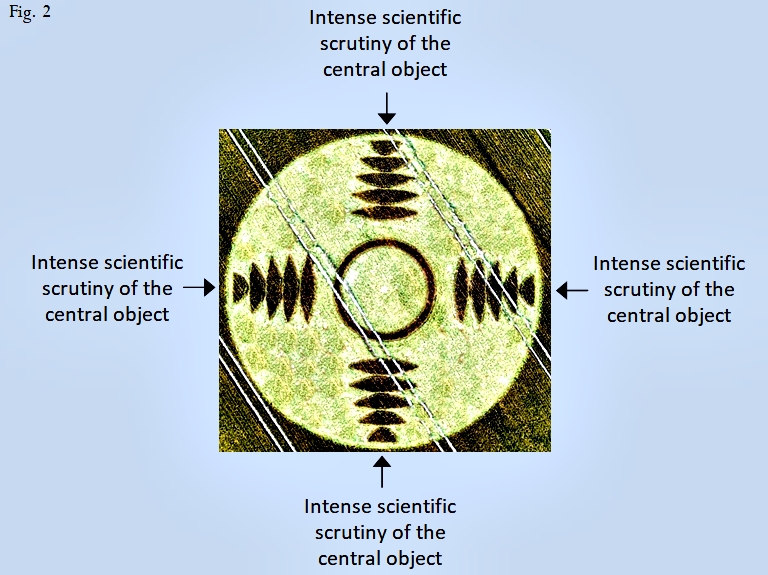
Secondly,
within the formation, 8 objects are in the closest proximity to the 1,
central circle and, in our base-10 system, the juxtaposition of the
digits '8 & 1' would infer the factor, 81, which, if bismuth was counted
with the stable elements, would represent its relative position in the
list of them, as illustrated below:
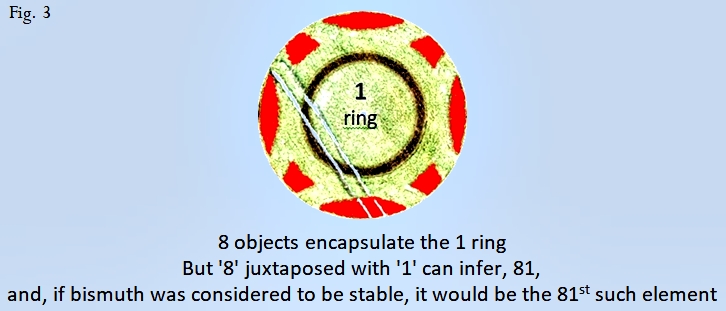
Thirdly, the formation's
largest and most prominent ring of objects is clearly the one that is
placed nearest to the structure's perimeter, and that particular ring
comprises 24 of them - a number that exhibits an intimate and
unambiguous relationship with bismuth. The 24th prime number** is, 83,
which happens to be the element's atomic number, as shown below:
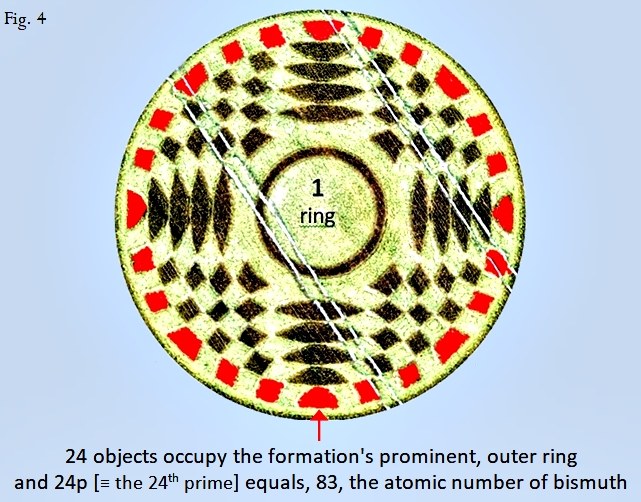
Fourthly, if the '24' tied to the formation's outer ring of objects
[shown above] is juxtaposed with the '1' associated with its inner
circle [as also shown above], the inferred number, 241, is the 54th
prime, and '54' - as children who have mastered their 'tables' know -
can be expressed as, six 9's. This is interesting because the product,
6px9p [= 6th prime x 9th prime], computes to, 209 [= 11x19], which is
also closely tied to the most stable isotope of bismuth I've cited: it
represents the quota of protons and neutrons in each atom's nucleus i.e.
209 = 83+126.
[A rapid deviation!]
As I was in the process of describing the above relationship, involving
the number 241, each of the two international cricket teams, at Lords,
in one of the most extraordinary matches ever witnessed, scored - in the
course of their 50 overs for the World Championship - 241 runs.
My identification, within the formation - which displays 80 + 1 internal
objects - of this set of apparent links to the element bismuth persuaded
me that we're probably being invited to find some form of relationship,
involving the 81 elements, which sheds light on another important
attribute of the field structure. It therefore occurred to me to
construct a simple table that sets out representations of all the
elements, from hydrogen to bismuth, including those that don't possess
any stable nuclides i.e. technetium [Atomic No. 43] & promethium [Atomic
No. 61], whose presence splits the 81 elements into three distinct
groups - as shown below, where, to avoid unnecessary clutter, I've shown
only the first and last members of each group:
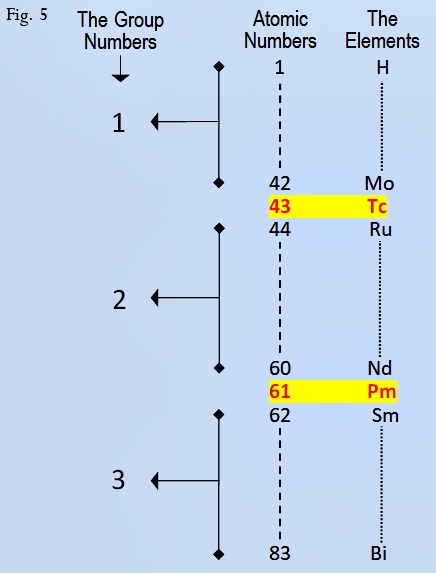
I found the 81 atomic numbers' sum to be, 3382 [= 3486 {= (1+…+83)} - 104 {=
(43+61)}], and past experience led me to suspect that the product of its prime
factors may be of interest i.e. 2x19x89, which can be expressed as, 2px9px25p
[= 2nd prime x 9th prime x 25th prime].
I noted that, 450, derived from the inferred, 2x9x25, exhibits a revealing
relationship with the factor, 123, which can be inferred by juxtaposing the
numbers that denote the three identified groups of elements i.e. 123p [= 673] +
450 = 189p [= 1123], where the inferred, 189, was the day of the year [in our
Western calendar] that the formation was discovered i.e. 08 July.
Furthermore, having identified this key role for the factor, 123p [= 673],
which was derived from the division of the list of elements into 3 groups, I
noted that the expression, 123p x 3, has a value that provides additional data
about the formation's date i.e. it's the familiar, 2019.
I would add that it is normal for the date of a formation's creation to be
expressed within it.
Before my conclusion of this article, which strikes a more sinister note for us
all, I shall show that the formation's ingenious creators also highlighted
another piece of data that I have been finding in crop circles for a very long
time [indeed it's rare for a formation to be devoid of it].
We know that it's possible to draw pairs of orthogonal lines, which intersect
at the centre of the formation, so that each line passes through two, facing
sets of five 'lenses' [as I call them] - and one such line pair is depicted in
the image below:
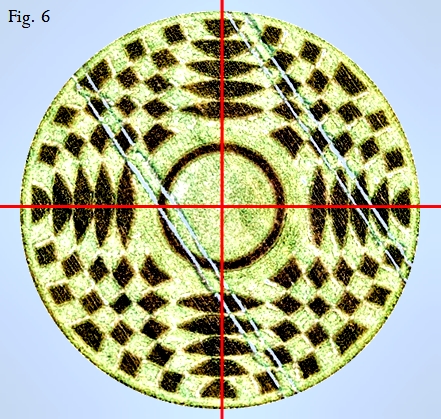
We also know, however, that it is not possible to construct pairs of
orthogonal lines, through the formation's centre, so that each line is
able to intersect all members of the two facing sets of the 15 other
objects [totalling 60, in all].
It’s clear, then, that the 'lenses' form two pairs, each of which is
collinear with the formation's centre, whereas the other objects - which
are in four sets of 15 - do not possess this attribute.
So we can now say that the 80 objects, which encompass the central
circle, can be defined as: two lots of 10 'lenses', and 60 other
objects.
This interested me because [as stated in previous articles] the
expression, [10p + 10p] x 60p, equates to, 12742 [= (23+23) x 277], the
up-to-date value, in kilometres, of the earth's mean diameter [it is
also the accurate 'geometric mean diameter' of the WGS 84 ellipsoid].
It's of interest to note, here, that as we now know that the 80 objects
encompassing the central circle can define the diameter of the earth [in
km], it could suggest that that circle also serves as a physical
representation of the planetary body. The question is therefore raised
as to how this role would relate to the links that also exist between
the circle and the element bismuth.
I believe it would now be helpful to reconsider the image I presented in
Fig. 2.
If we subject the name of the element, BISMUTH, to a form of the
'intense scientific scrutiny' that was being alluded to we can easily
find a definitive link to a far more sinister substance.
We know that the word was formed by the juxtaposition of 7 letters of
our alphabet, an entity that is comprised of 26 such characters. And if
each member of the latter is given a value that represents its relative
position [which constitutes an extremely simple cipher] i.e. A=1, Z=26,
the word will have the value, 92 [= 2+9+19+13+21+20+8].
Many readers, even with a rudimentary knowledge of science, will know
that the factor we've now produced represents the atomic number of,
uranium. They'll also probably be aware that this element is the prime
constituent of atomic bombs [although plutonium can also be used]. And
the far more destructive thermonuclear bombs need, in addition, the
element hydrogen. [Note: I won't even attempt to describe fully the
complexities of thermonuclear bombs].
Having recognised this elementary manifestation of the important number,
92, I knew it was imperative that I sought other evidence, within the
formation, that this was not just a random result - and I didn't have to
look very far to find it.
Firstly, an inspection of how the letters of BISMUTH occur within the
alphabet revealed that they split it into 9, distinct sections, as
illustrated below:

And when 9
is added to bismuth's atomic number, 83, we obtain - 92 - the atomic
number of uranium.
Secondly, the placing of this pivotal relationship within a set of
characters that number, 26, is suggestive that the latter factor also
has a key role to play. And when it's added to the number that defines
the type of bismuth that is most stable, 209 [its tally of protons and
neutrons], we obtain, 235, which defines the type of uranium that is
employed in thermonuclear bombs i.e. uranium-235 [which possesses 92
protons and 143 neutrons].
I believe it is also important to add that as this information has been
linked to the 1 circle that occupies the formation's centre, it provides
strong support for my analysis. This circle, which is tied to the number
'1' because it is solitary, could also serve as a representation of the
other key component of a thermonuclear bomb, hydrogen [of atomic number,
1].
I would suggest, then, that the formation is giving us a serious warning
about the dangers we face at this point in time from thermonuclear
warfare. I am confident that its architects are as aware as I am that
the detonation of just one such device, in an act of aggression, would
bring about an immediate collapse of the world's financial markets and
economies, precipitating an unprecedented state of global chaos and
anarchy, with unimaginable human suffering.
But, for the moment, I shall return my attentions to this season's
remarkable, first formation, which I was analysing when Steve
Alexander's image of the Farley Mount structure came in. It is my
contention that that Norridge Wood circle - when coupled with its
predecessor of last year - shall prove to be a watershed in the vexed
history of the whole subject.
Notes from the text
*
Near the
beginning of the Second Millennium, a colleague of mine and I were
engaged in an excavation in a remote woodland clearing, in South Wales.
I'd been drawn to this point after many years of studying both the
so-called Arthurian legends and a curious work entitled Sir Gawain and
the Green Knight. The trench we dug on the first day produced nothing,
and by lunchtime, on the next day, I feared that my computations were
not as accurate as I'd thought. But as we were sitting, on a fallen
trunk, chatting and eating our food, an extraordinary event occurred
alongside us - one that I will never forget. As I reached for a bottle,
I saw, next to the trench we had dug, a pristine circle, of six feet
diameter, in the short grass. When we had recovered our composure, after
this odd occurrence, I knew immediately what this neat circle was
communicating to us - dig at the centre! And when we did, we quickly
excavated exactly what I had been looking for. I later learned why the
circle had been of the cited size.*
So I know with 100% certainty that a massive intelligence is providing
us with crop circles. I also know for certain that this is being done to
help those who are prepared to listen.
**
During my early studies - involving a spectrum of ancient texts - I
discovered that I could not make sense of their numerical sections until
I made a basic change to the way prime numbers are defined and
processed. For quite a long time mathematicians have elected to consider
the first prime to be '2', but the ancients were adamant that the first
of these special numbers is '1'. And when I made this change, the
ancient texts I was studying yielded masses of information that analysts
had been unable to find - some of it being of immense, historical
significance.
Furthermore, when I started examining crop formations, years later, I
found that much of the data they embody can only be found when the
ancient understanding of primes is adhered to.
In essence, as '1' is the only positive integer that's exactly divisible
by itself alone, it was seen to be the only true prime. The other
numbers that are now called prime, commencing with '2', were classified
as secondary primes [which is more logical than the current system].
In lists of primes, then, '1' must be included, at the beginning, which
reflects its unique status.
The 24th prime is therefore, 83, and not the '89' quoted in conventional
lists of primes.
* The relevance of that circle's diameter is a feature that carries over
to structures that we see in our fields today. Their dimensions often
embody critically important data, which enables a serious analyst to
unravel further strands of their overall communications. Those who are
fortunate enough to visit them, then, should do their best to take some
simple measurements, with great care, of course. A fairly long tape
should therefore be an essential possession of an aspiring crop circle
investigator. I can remember that, many years ago, Andy Thomas and his
gang always used to measure the formations they visited and that should
be done today, if it's at all possible. And as most mobile phones now
possess a 'gps' facility, measurements of the geographical coordinates
of various key points [ref. the WGS 84 datum] should also be taken.
I would add that it would be desirable if such data was available for
the Farley Mount circle.
Neil Hudson Newman
|